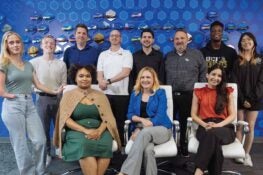Class Name
WST3371 Women and Leadership
Instructor
Anne Bubriski
When is it offered?
Spring.
How many students in a class?
Honors: Maximum 20.
Online: Maximum 45.
Prerequisites
ENC1102 (Composition II)
From the Professor
Why should a student take this class?
It’s so empowering for the students. It’s one of my favorite classes. The first day the students fill out a profile page and one of the questions I ask is, “What do you want to get out of this? What is your main goal?” A lot of them say, “I want to learn better leadership skills,” or “I want to learn about women leaders in the past and present.” This is a great class because we talk about all these amazing women that are often ignored. We discuss the challenges, obstacles and successes women have in gaining leadership positions with specific emphasis on diversity of experiences. I think it opens their eyes — they can see themselves in the future being a leader
What does the coursework entail?
I’ve been known to be reading heavy. I tell them, if you read and think critically about things, you’ll be fine in my class. I also try to be engaging with activities and assignments and bring as many women leaders’ voices into the class through guest lectures and films. I want students to come away from class like, “Wow I learned a lot.”
In the beginning of the course we talk about leadership styles and theories. The students complete worksheets that analyzes their own strengths, what they personally bring to the table. In terms of the historical part, I like the students to be engaged and do their own research. I set up a Wiki page titled the women’s leaders collection. Students have to post blurbs about two women leaders that link to a reputable source. I require that one of the leaders needs to be not mainstream media, and one of the leaders must be a woman of color. Once the page is full of leaders, the students are then required to fill out a table, placing the leader’s name in their appropriate industry — are they arts? Law? Education? Politics? I think they really end up loving the exercise. Some of my students said, “Dr. Anne I’m so glad you assigned that because I’ll be honest, I usually post and go. But when you had us do that table and we read about all the women, it brought me to tears.” And that’s why I do it. It made such an impact in their life and their empowerment to seek out their own dreams and goals.
Who are three contemporary women leaders that everyone should know?
Malala (Yousafzai). She’s a young woman leader but what she sacrificed and went through in women and girls’ education is “sheroic.”
I think Shondra Rhimes is a good contemporary one. We’ve been talking a lot about her in class. We watch this clip and she talks about how she hasn’t really broken the glass ceiling because she doesn’t have any cuts; it’s the women who came before her and she was able to just go through it. She is a mom so she talks about how to negotiate that while having a thriving career. She’s so much about breaking stereotypes and building diversity and equity. I see students really resonating with her message, in part because she’s broken so many barriers.
My personal “shero” is Michelle Obama. She’s all about empowering the community, reaching those that maybe have been left behind, bringing them to the table, providing a space for voices that have historically and continually been marginalized and ignored. She was vice president at a medical center while raising two girls while Barack Obama was traveling a lot. Probably because I’m a mom, too, that really hits home. It’s very difficult to rise up the ranks when you have family obligations.
In January, Kamala Harris was inaugurated as this country’s first woman vice president. What is the significance of that milestone and how do you think it will impact future generations?
Kamala Harris being elected as the first woman vice president is monumental. She not only broke the glass ceiling for women, but she did so for all women as a woman of color. As a Black and Asian American woman, girls of so many backgrounds can identify and actually see themselves in Harris. While there are still many gender and racial barriers to top-level leadership, Harris’ achievement and position is a powerful message of hope and inspiration for young people of all backgrounds to never stop reaching and working for their dreams even when faced with adversities.
“My hope is that they identify their strength as student leaders and see themselves somewhere at some point in the course in an accomplished woman leader.”
What do you hope your students learn?
I’m a facilitator of knowledge. I’m not here to make you think one way or another. I’m here to present information, and I want you to critically examine it. You might be uncomfortable with some of it, but that’s part of learning and growth. Throughout the course, my hope is that they identify their strength as student leaders and see themselves somewhere at some point in the course in an accomplished woman leader.
Ideally when they go into the workforce, they will engage in that kind of transformational, feminist leadership we discuss in class that we feel is so collaborative, unifying and empowering.
What is feminist leadership?
The point is to bring voices to the table, so it’s not just this top-down approach. That leader looks for input from whether it’s the student intern to the executive director’s assistant to the president of the organization. It’s much more collaborative. There’s also an emphasis with the organization’s mission that it does something for the betterment of the surrounding community. It makes positive social change.
From the Student
-Mariah Fermin, psychology major with a minor in women’s and gender studies.
Why did you take this course?
Dr. Bubriski co-runs a mentoring program for 7th grade girls at UCF called SLAM. The class was a requirement to be a facilitator for the program, which I am now.
The class is interesting. I read the syllabus beforehand, and she had this project we had to do where we interviewed a woman leader under the age of 30. It was really interesting to see all the leaders under the age of 30, some even under the age of 20, doing all these activities and positively changing the world.
What did you like most about the course?
I took the course online, but I still connected with everyone in the class. Dr. Bubriski made sure we had activities that were discussion based.
What is the most interesting thing you learned?
Reading the women’s stories in that big project I mentioned. Knowing that these women are able to do it — make an impact, go after their goals — it gives me confidence that I’m able to do it, too. And I can show other women they are able to do it.
“When I came here, I had no idea what was going on with women around the world. UCF changed that for me.”
What was the most challenging aspect?
Dr. Bubriski likes to give a lot of articles and some articles are hard to read – it’s emotionally and mentally taxing. These women are where they are now because a bunch of horrible things have happened to them. I feel like if you’re uncomfortable, you’re learning and growing, and I think being in this minor and being in her classes helps broaden your way of thinking. When I came here, I had no idea what was going on with women around the world. UCF changed that for me.





